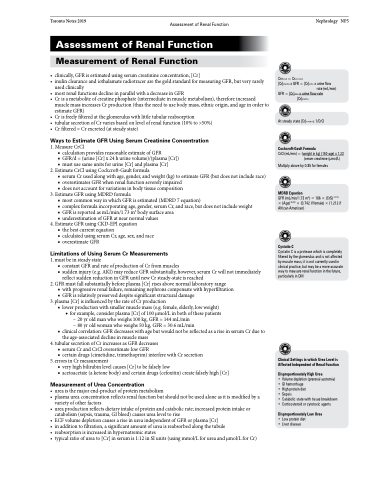Page 705 - TNFlipTest
P. 705
Toronto Notes 2019 Assessment of Renal Function Assessment of Renal Function
Measurement of Renal Function
• clinically,GFRisestimatedusingserumcreatinineconcentration,[Cr]
• inulinclearanceandiothalamateradiotracerarethegoldstandardformeasuringGFR,butveryrarely
used clinically
• most renal functions decline in parallel with a decrease in GFR
• Crisametaboliteofcreatinephosphate(intermediateinmusclemetabolism),thereforeincreased
muscle mass increases Cr production (thus the need to use body mass, ethnic origin, and age in order to
estimate GFR)
• Crisfreelyfilteredattheglomeruluswithlittletubularreabsorption
• tubularsecretionofCrvariesbasedonlevelofrenalfunction(10%to>50%)
• Crfiltered≈Crexcreted(atsteadystate)
Ways to Estimate GFR Using Serum Creatinine Concentration
1. Measure CrCl
■ calculation provides reasonable estimate of GFR
■ GFR/d = (urine [Cr] x 24 h urine volume)/(plasma [Cr]) ■ must use same units for urine [Cr] and plasma [Cr]
2. Estimate CrCl using Cockcroft-Gault formula
■ serum Cr used along with age, gender, and weight (kg) to estimate GFR (but does not include race) ■ overestimates GFR when renal function severely impaired
■ does not account for variations in body tissue composition
3. Estimate GFR using MDRD formula
■ most common way in which GFR is estimated (MDRD 7 equation)
■ complex formula incorporating age, gender, serum Cr, and race, but does not include weight ■ GFR is reported as mL/min/1.73 m2 body surface area
■ underestimation of GFR at near normal values
4. Estimate GFR using CKD-EPI equation
■ the best current equation
■ calculated using serum Cr, age, sex, and race ■ overestimate GFR
Limitations of Using Serum Cr Measurements
1. must be in steady state
■ constant GFR and rate of production of Cr from muscles
■ sudden injury (e.g. AKI) may reduce GFR substantially, however, serum Cr will not immediately
reflect sudden reduction in GFR until new Cr steady-state is reached
2. GFR must fall substantially before plasma [Cr] rises above normal laboratory range
■ with progressive renal failure, remaining nephrons compensate with hyperfiltration
■ GFR is relatively preserved despite significant structural damage 3. plasma [Cr] is influenced by the rate of Cr production
■ lower production with smaller muscle mass (e.g. female, elderly, low weight) ◆ for example, consider plasma [Cr] of 100 μmol/L in both of these patients
– 20 yr old man who weighs 100 kg, GFR = 144 mL/min
– 80 yr old woman who weighs 50 kg, GFR = 30.6 mL/min
■ clinical correlation: GFR decreases with age but would not be reflected as a rise in serum Cr due to
the age-associated decline in muscle mass
4. tubular secretion of Cr increases as GFR decreases ■ serum Cr and CrCl overestimate low GFR
■ certain drugs (cimetidine, trimethoprim) interfere with Cr secretion 5. errors in Cr measurement
■ very high bilirubin level causes [Cr] to be falsely low
■ acetoacetate (a ketone body) and certain drugs (cefoxitin) create falsely high [Cr]
Measurement of Urea Concentration
• ureaisthemajorend-productofproteinmetabolism
• plasmaureaconcentrationreflectsrenalfunctionbutshouldnotbeusedaloneasitismodifiedbya
variety of other factors
• ureaproductionreflectsdietaryintakeofproteinandcatabolicrate;increasedproteinintakeor
catabolism (sepsis, trauma, GI bleed) causes urea level to rise
• ECFvolumedepletioncausesariseinureaindependentofGFRorplasma[Cr]
• inadditiontofiltration,asignificantamountofureaisreabsorbedalongthetubule
• reabsorptionisincreasedinhypernatremicstates
• typicalratioofureato[Cr]inserumis1:12inSIunits(usingmmol/Lforureaandμmol/LforCr)
Nephrology NP5
Crfiltered = Crexcreted
[Cr]plasma x GFR = [Cr]urine x urine flow
rate (mL/min) GFR = [Cr]urine x urine flow rate
[Cr]plasma
At steady state [Cr]serum α 1/CrCl
Cockcroft-Gault Formula
CrCl (mL/min) = (weight in kg) (140-age) x 1.23 (serum creatinine (μmol/L)
Multiply above by 0.85 for females
MDRD Equation
GFR (mL/min/1.73 m2) = 186 × (CrS)-1.154 × (Age)-0.203 × (0.742 if female) × (1.212 if African American)
Cystatin C
Cystatin C is a protease which is completely filtered by the glomerulus and is not affected by muscle mass; it is not currently used in clinical practice, but may be a more accurate way to measure renal function in the future, particularly in DM
Clinical Settings in which Urea Level is Affected Independent of Renal Function
Disproportionately High Urea
• Volume depletion (prerenal azotemia) • GI hemorrhage
• High protein diet
• Sepsis
• Catabolic state with tissue breakdown • Corticosteroid or cytotoxic agents
Disproportionately Low Urea
• Low protein diet • Liver disease


